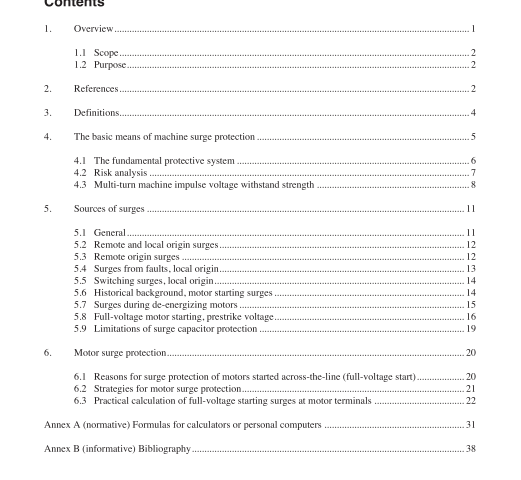IEEE C62.21-2003 pdf download.IEEE Guide for the Application of Surge Voltage Protective Equipment on AC Rotating Machinery 1000 V and Greater
4. The basic means of machine surge protection
The basic means of protecting machines from surges has been to slow the rate of surge voltage rise by a series circuit of inductance and capacitance, and to limit the voltage that can be impressed on that circuit by surge arresters.
The inductance may be only that of the machine leads (supply or output cable) or a trans- former. Because the surge is a voltage from phase to ground, the capacitance of the supply or output cable may be only the capacitance to ground, or it may be a surge protective capacitor connected between machine terminals and grounded frame. [B43] If a constant voltage E a is suddenly impressed on an inductance L and a capacitance C in series, as in Figure 1, the voltage across the capacitance e c will be an oscillatory one, oscillating about E a until the losses in the circuit damp out the oscillations.
The period is . It reaches its peak in the time T/2 . By properly choosing the values of L and C , then a minimum time T/2 can be fixed. This alone, however, does not set a limit to the rate-of-rise e c . The voltage E a must be limited also. Two values of E a are shown in Figure 2 to illustrate that if E a is increased, the rate-of-rise is also increased because T/2 remains the same.
The following three elements are required to limit the rate-of-rise of
— A capacitance
— An inductance
— A means of limiting
In practice, E a is fixed by a surge arrester between the surge source and the inductance. The machine is con- nected in parallel with the capacitance, so that the surge voltage across the capacitor, e c , is impressed between terminal and machine frame.
These three components do not protect completely. Figure 2 shows that an undamped voltage e c can rise the- oretically to twice the value of E a by oscillation. In practice, this is not likely because of damping. However, the crest of e c may exceed E a by a considerable amount and endanger the groundwall insulation. It will usu- ally be necessary to restrain e c to a value even less than E a in order to insure good protection. This is done by applying a second surge arrester, in parallel with the capacitor at the machine terminals. Then, when e c rises to the discharge voltage of this second arrester, it limits e c as indicated by the dashed line in Figure 2.
4.1 The fundamental protective system
The complete basic protection circuit for rotating machines is shown in Figure 3 [B43]. It consists of four components. Arrester, A L , limits the incoming voltage. The inductance L and capacitance C lengthen the time to crest and limit the rate-of-rise of the voltage at the machine terminal. Arrester, A M , limits the magni- tude of the voltage from the machine terminal to frame.
The inductance can be a lumped inductance such as a coil or a current-limiting reactor, but is usually a trans- former or a length of the incoming line or cable. The capacitance is usually a capacitor, but if the circuits are in cable, the cable capacitance may be sufficient. The line arrester, A L , is usually a standard distribution or intermediate class arrester. The arrester at the machine, A M , is usually one designed especially for this pur- pose with low discharge voltage. Energy absorption capability has not been a problem for these specially designed rotating machine protection arresters.IEEE C62.21 pdf download.IEEE C62.21-2003 pdf download
IEEE C62.21-2003 pdf download

Leave a Reply